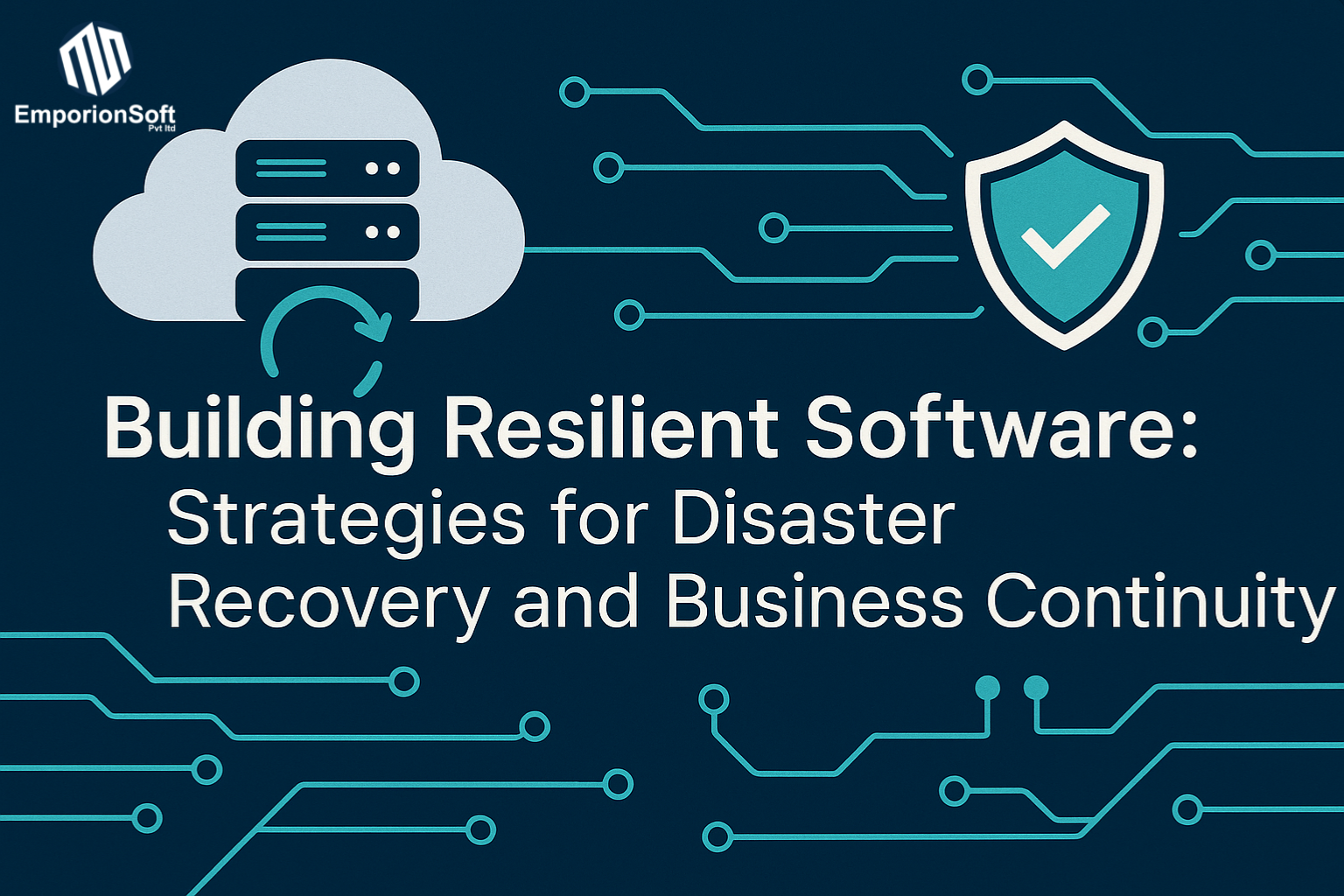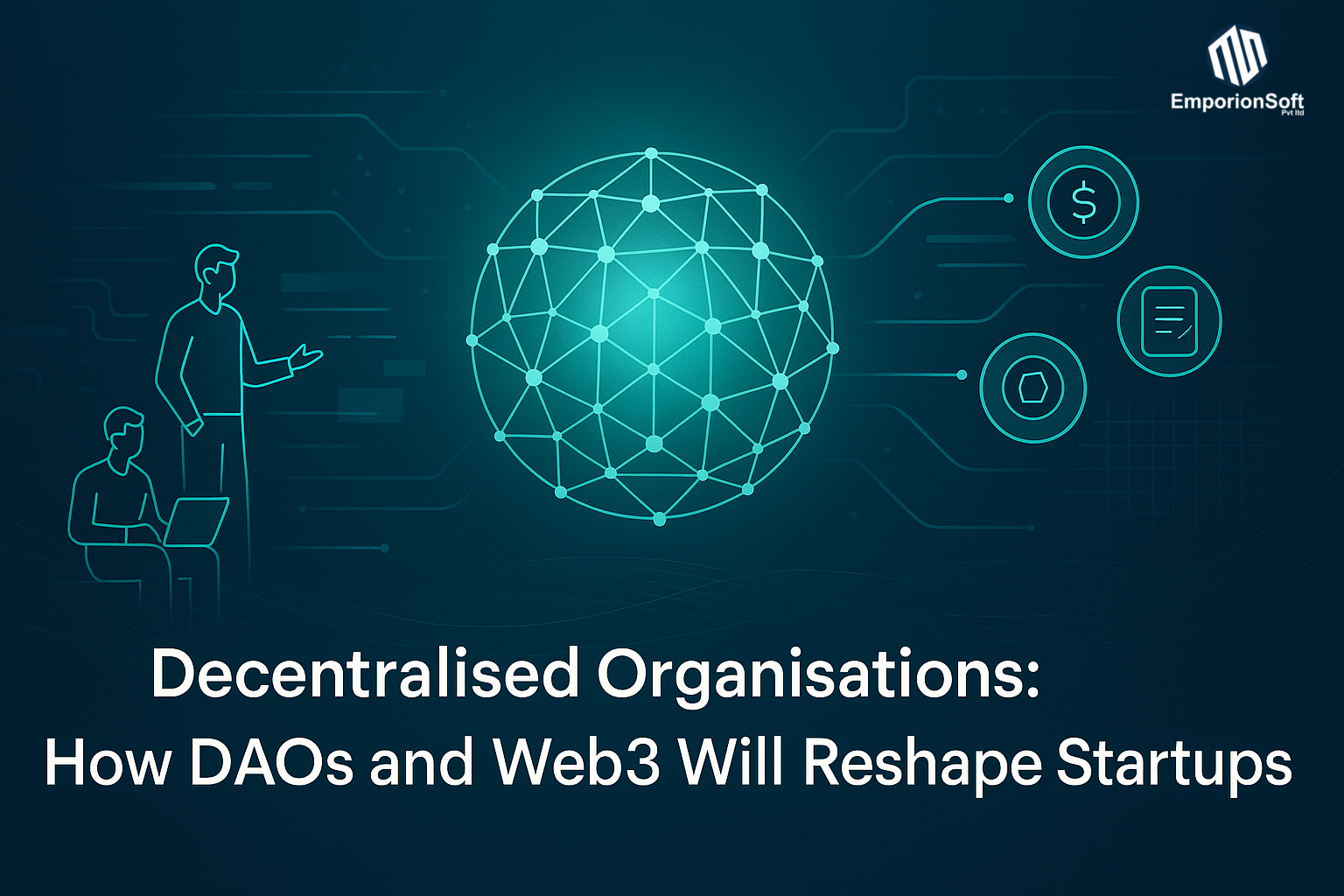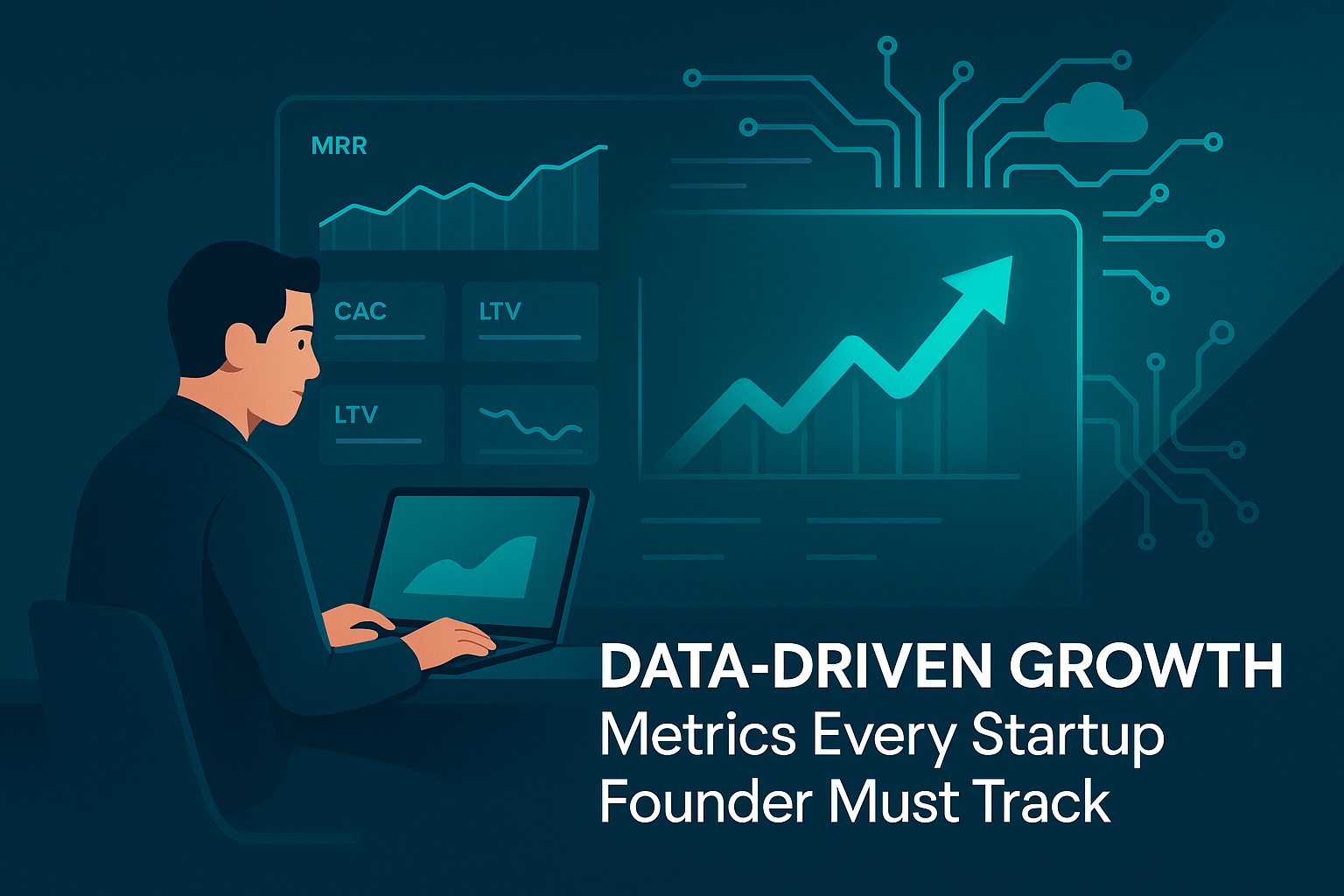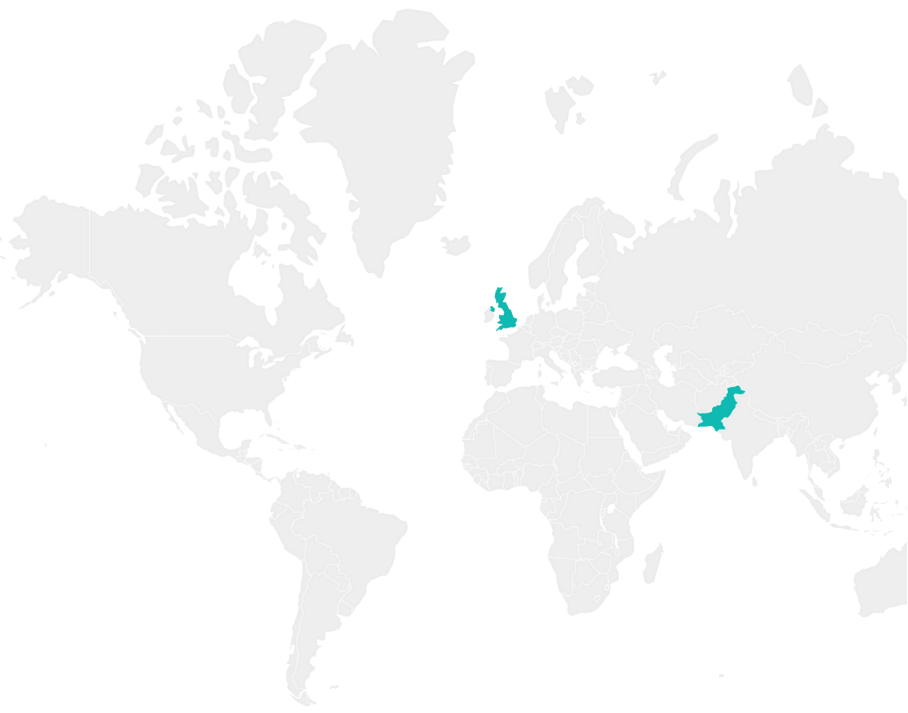Why Resilient Software Matters in 2025
In an age of global disruption, your business is only as resilient as the software behind it. Whether it’s a cyberattack, natural disaster, or cloud outage, every minute of downtime can cost thousands—sometimes millions. According to IBM’s Cost of a Data Breach Report 2023, the average data breach costs $4.45 million, with system downtime being a significant contributor ¹.
For companies operating in fast-paced digital environments, resilience is not a luxury—it’s a necessity.
Resilient software refers to systems architected to withstand, adapt to, and recover from unexpected failures. It encompasses both disaster recovery plans for IT systems and long-term business continuity software solutions. Simply put, resilient software ensures that critical operations continue, no matter what happens.
At EmporionSoft, we help organisations design systems built not only for performance but also for durability and recoverability. Our clients, ranging from fintech to healthtech, rely on robust, scalable systems that keep their businesses running—even under pressure. Explore some of our recent case studies to see how we’ve implemented resilient solutions across sectors.
Understanding the Landscape of Risk
Today’s digital infrastructure is deeply interconnected. A single point of failure in one system can ripple through an entire ecosystem. From third-party SaaS outages to DDoS attacks and natural calamities, modern software must be prepared to respond proactively.
Resilient software architecture is designed to anticipate these threats. It leverages strategies like distributed services, fault isolation, real-time monitoring, and automated recovery to ensure uninterrupted operations. This approach isn’t only about technology—it reflects a mindset of readiness.
Disaster Recovery and Business Continuity: A Combined Strategy
Many organisations mistakenly treat disaster recovery (DR) and business continuity (BC) as separate concerns. In reality, they must work together. A disaster recovery plan for IT systems ensures quick restoration of technology services. Meanwhile, business continuity software solutions focus on maintaining overall operations—including communication, workflows, and customer service.
When designed cohesively, these strategies build the foundation for true software resilience. At EmporionSoft, we integrate both DR and BC into every software development lifecycle, aligning them with your business goals and risk profile. If you’re planning a transformation or currently scaling, explore our services for tailored resilience engineering.
Looking Ahead
As we move further into 2025, the demand for high-availability systems will continue to rise. Enterprises that fail to prioritise resilience risk falling behind—not just technologically, but competitively. This blog series will walk you through actionable strategies for building resilient software, preparing your organisation for anything the future holds.
In the next section, we’ll explore the core principles of resilient software architecture, and how they empower businesses to thrive even during disruption.
Sources:
[1] IBM. Cost of a Data Breach Report 2023. https://www.ibm.com/reports/data-breach
Core Principles of Building Resilient Software
Building resilient software is not just about reacting to failure—it’s about designing with failure in mind. In today’s ever-connected and high-stakes environments, businesses must engineer systems that expect disruption and respond without collapsing. This section outlines the core architectural principles that underpin fault-tolerant, reliable digital systems—each playing a vital role in maintaining uptime, ensuring customer trust, and enabling business continuity.
Fault Tolerance: Surviving the Inevitable
Every system encounters failure eventually. The key to resilience lies in a system’s ability to continue functioning despite faults—a concept known as fault tolerance. By isolating failures and preventing them from cascading, fault-tolerant systems reduce the likelihood of full-scale outages.
For example, when a microservice fails, a fault-tolerant architecture reroutes traffic to a backup or triggers retries with exponential backoff. This keeps users largely unaffected, ensuring continuity of service while internal recovery takes place.
Redundancy: Eliminating Single Points of Failure
Redundancy means creating multiple instances of critical components, so that if one fails, others take over. This could include redundant servers, databases, load balancers, or even geographically separate data centres.
Redundant architecture ensures that high availability is more than a goal—it’s a guarantee. At EmporionSoft, we advocate for both active-active and active-passive configurations depending on cost, performance, and availability targets. For real-world implementation examples, visit our Our Insights section, where we dive deeper into infrastructure strategies.
Failover Strategies: Ensuring Seamless Continuity
Failover is the automated process of switching to a standby system when the primary one fails. The speed and transparency of this process are critical to preserving user experience. Failover mechanisms can be implemented at various levels—from DNS failover for regional disruptions to database replicas for localised failures.
Effective failover strategies minimise service disruption and preserve transactional integrity. They form a core part of any software disaster mitigation plan.
Graceful Degradation: Minimising Impact on Users
Rather than failing completely, resilient systems are designed to degrade gracefully. This means when full functionality is unavailable, critical services continue to work.
For instance, a streaming service might temporarily disable HD playback during server stress while keeping standard definition operational. This approach reduces user frustration and maintains partial business operations even under strain.
Observability: The Heartbeat of Resilience
Observability allows engineers to understand system behaviour in real time. It encompasses metrics, logs, traces, and alerting systems that give visibility into how components are functioning.
Modern observability platforms like Prometheus and OpenTelemetry help detect anomalies early, enabling proactive disaster mitigation. A truly resilient system doesn’t just survive failure—it communicates what’s happening and why. Learn more about how EmporionSoft integrates observability in software lifecycles via our About Us page.
🔍 Quick Summary: Key Principles of Resilient Architecture
-
Fault Tolerance: Keep services running despite internal failures.
-
Redundancy: Duplicate critical components to avoid single points of failure.
-
Failover: Switch seamlessly to standby systems when needed.
-
Graceful Degradation: Deliver core services even during disruption.
-
Observability: Gain full visibility and fast incident response.
These principles provide the blueprint for building resilient software capable of withstanding uncertainty. When layered together, they form the bedrock of disaster recovery and long-term business continuity.
For deeper architectural guidance, refer to the AWS Well-Architected Framework, which offers a comprehensive model for cloud resilience.
Designing for Failure: Best Practices in Software Architecture
In the world of modern software development, failure is inevitable—but downtime is not. To achieve true resilience, software must be engineered with failure as an expected event, not a rare exception. By applying specific architectural patterns and operational strategies, organisations can reduce the blast radius of issues, preserve user experience, and uphold business continuity.
Chaos Engineering in Production: Controlled Breakage for Stronger Systems
Chaos engineering is the practice of intentionally introducing failure into a system to test its ability to recover. It originated at Netflix and has since become a gold standard for resilience testing. By breaking things before they break naturally, teams uncover hidden weaknesses in their systems.
In production environments, chaos engineering helps organisations refine their resilient microservices architecture. Fault injection, latency simulation, and node failures all expose how systems behave under stress—allowing teams to improve before real customers are affected.
🛠️ A great starting point for implementing chaos engineering is Netflix’s open-source tool Chaos Monkey (DoFollow), which randomly terminates instances in production to test auto-recovery mechanisms.
Circuit Breakers and Retries: Smart Error Handling at Scale
A major failure pattern in distributed systems is cascading failure, where one fault leads to others collapsing. To prevent this, architects use circuit breakers—components that stop requests to a failing service, letting it recover without overloading.
Paired with circuit breakers are retry mechanisms with exponential backoff, which pause and space out retry attempts. This ensures systems don’t hammer a failing service with repeated requests, which could worsen the outage.
These patterns are critical in distributed systems design, particularly in systems that rely on multiple APIs or cloud services. They improve latency handling and maintain service availability during partial outages.
Fault Isolation in Microservices: Contain the Blast Radius
The microservices model naturally promotes modularity, but without proper isolation, a single faulty service can impact the entire application. Implementing fault isolation means designing services so that failures stay localised and don’t propagate.
This can be achieved through:
-
Service segmentation by domain
-
Timeout controls on service-to-service calls
-
Bulkheading, where services run in isolated resource pools
This architecture ensures that if one service fails—say, payment processing—the rest of the system (e.g. browsing, cart) remains functional. For examples of this approach in production, visit our Case Studies where we showcase real-world fault isolation designs.
Embracing Eventual Consistency: Prioritising Availability
In distributed systems, strong consistency often comes at the cost of availability. That’s why many resilient architectures adopt eventual consistency—the idea that systems synchronise data over time rather than immediately.
This is especially valuable in global systems where immediate consistency is impractical. For example, a ride-sharing app might temporarily show outdated ride statuses to some users, but eventually all systems align. This trade-off boosts uptime while keeping operations running.
🧠 Case Snapshot: Failure-Resilient E-Commerce Platform
A global e-commerce client approached EmporionSoft to build a platform that could withstand traffic surges and external API failures. Our team:
-
Implemented circuit breakers around the payment gateway
-
Introduced retry with backoff for third-party logistics APIs
-
Applied chaos engineering during staging rollouts
-
Designed microservices with localised fault tolerance
The result? A 99.98% uptime rate during Black Friday, with zero lost transactions even when external services faltered. Want similar results? Contact us to design failure-proof systems tailored to your domain.
The Role of Cloud Infrastructure in Resilience and Continuity
In today’s digitally reliant world, cloud computing forms the backbone of resilient software systems. As organisations prioritise uptime and disaster preparedness, cloud platforms like AWS, Azure, and Google Cloud have become essential to achieving business continuity and disaster recovery at scale. A well-architected resilient cloud infrastructure not only reduces risk—it enables rapid recovery, operational flexibility, and global reach.
Multi-Region Deployment: Minimising Single-Point Failure
One of the cloud’s most powerful resilience features is multi-region deployment. By distributing services and data across multiple geographic regions, organisations can ensure failover capabilities in the event of a localised failure—be it a data centre outage or a natural disaster.
For example, a financial institution can run production workloads in the UK and replicate critical databases in Ireland or Germany. In the event of downtime in one region, traffic is seamlessly routed to another.
🧭 Common Multi-Region Tools:
-
AWS Route 53: DNS-based traffic management and health checks
-
Azure Traffic Manager: Global load balancing across Azure regions
-
GCP Load Balancer: Multi-regional, scalable load distribution
This approach significantly improves cloud-based disaster recovery by eliminating dependency on a single zone or region.
Automatic Backups: Reliable Data Recovery at Speed
A foundational element of disaster recovery is routine, automated backups. Cloud providers offer snapshot-based and incremental backups for databases, object storage, and virtual machines.
These backups:
-
Run on pre-set schedules
-
Support rapid restores with minimal downtime
-
Include versioning for rollback options
Services like AWS Backup, Azure Backup Vault, and Google Cloud Backup and DR simplify the task of protecting your critical assets—reducing RTO (Recovery Time Objective) and RPO (Recovery Point Objective) in your DR strategy.
Container Orchestration and Kubernetes: Resilience at Scale
For modern, microservice-driven applications, Kubernetes has become the de facto orchestration platform. It offers built-in mechanisms for:
-
Self-healing containers
-
Rolling updates
-
Auto-scaling based on demand
-
Graceful shutdown and recovery
These features allow teams to build resilient cloud architecture that adapts in real time. Kubernetes can be deployed on managed platforms like:
-
Amazon EKS
-
Azure AKS
-
Google GKE
Kubernetes ensures continuity by automatically replacing failed pods, scaling during usage spikes, and managing dependency health across services.
Infrastructure as Code (IaC): Automating Recovery
Infrastructure as Code (IaC) allows teams to define, provision, and update infrastructure through version-controlled scripts. With tools like Terraform, AWS CloudFormation, or Azure Bicep, you can rebuild environments in minutes after a disaster.
IaC enables:
-
Repeatable, error-free deployments
-
Rapid environment restoration
-
Compliance and auditability
This level of automation is critical to ensuring business continuity on AWS or Azure, especially in regulated industries.
🧰 Cloud Tools for Disaster Recovery & Continuity
| Service | Provider | Purpose |
|---|---|---|
| AWS Route 53 | Amazon | Global DNS failover & routing |
| Azure Backup Vault | Microsoft | Automated backups & restores |
| Google Cloud Load Balancer | Global multi-region distribution | |
| Terraform | HashiCorp | IaC for cloud provisioning |
| Amazon EKS / Azure AKS | Amazon / Microsoft | Managed Kubernetes |
To learn how EmporionSoft deploys resilient cloud solutions across industries, visit our Services or request a Consultation with our cloud specialists.
For best practices on resilient architecture, refer to the AWS Resilience Hub Documentation (DoFollow)—a trusted guide for designing and testing fault-tolerant systems.
Implementing Disaster Recovery Plans: Strategies & Tools
In the pursuit of building resilient software: strategies for disaster recovery and business continuity, the implementation of a robust Disaster Recovery (DR) plan is non-negotiable. It’s not enough to build fault-tolerant systems—organisations must prepare for failure with documented, tested, and measurable plans that ensure swift recovery and minimal disruption.
Whether due to cyberattacks, infrastructure failure, or natural events, downtime costs businesses both revenue and reputation. A well-executed DR strategy supports continued operations, protects data, and enables business continuity testing that aligns with real-world threats.
Start with RTO and RPO: The Foundations of Recovery
Two of the most crucial benchmarks in any DR plan are:
-
Recovery Time Objective (RTO): The maximum time a system can remain offline after a disruption.
-
Recovery Point Objective (RPO): The maximum acceptable amount of data loss measured in time.
These metrics define your tolerance for downtime and data loss. Setting them accurately ensures your disaster recovery automation efforts are aligned with your business needs and customer expectations.
Key Practices for Effective Disaster Recovery Implementation
Modern disaster recovery goes far beyond manual server resets and static documentation. To be truly resilient, your systems must incorporate:
🔁 Automated Failover Testing
Run regular, automated simulations to validate how systems behave when primary services fail. Tools like AWS Route 53 failover and Azure Site Recovery enable automatic redirection to healthy systems.
🌍 Offsite and Cloud Backups
Backups should never reside in the same location as production data. Use cloud-based DRaaS solutions to replicate systems and data to geographically remote environments for swift recovery.
📜 Incident Playbooks
Create detailed incident response guides that outline roles, responsibilities, and technical procedures. This ensures your teams know exactly what to do during an outage.
🖥️ Real-Time Monitoring and Alerting
Integrate continuous monitoring using tools like Prometheus, Datadog, or CloudWatch. Alerts should be proactive, not reactive—letting you detect and address potential issues before they impact end users.
Explore further best practices and case examples in our curated technical write-ups in Our Insights.
✅ Disaster Recovery Implementation Checklist
-
Define RTO and RPO across all critical systems
-
Deploy cloud-based offsite backups
-
Use infrastructure as code (IaC) for rapid rebuilds
-
Implement and test automated failover mechanisms
-
Write and circulate team-specific incident playbooks
-
Integrate real-time observability and alerting tools
-
Conduct quarterly business continuity testing drills
-
Partner with a trusted DRaaS provider
DRaaS Solutions and External Resources
For scalable, secure, and cost-effective DR, many organisations turn to Disaster Recovery as a Service (DRaaS) platforms like:
-
Veeam Disaster Recovery Orchestration (DoFollow)
-
Zerto IT Resilience Platform (DoFollow)
-
NIST SP 800-34 Rev.1 – Contingency Planning Guide (DoFollow)
These tools automate recovery, ensure compliance, and reduce the burden on internal IT teams.
At EmporionSoft, we’ve helped global businesses implement DR plans that not only meet compliance requirements but also provide peace of mind under pressure. If you’re looking to review or design your DR strategy, contact us to speak with our continuity specialists.
Business Continuity Planning: Beyond the Tech Stack
In software resilience, the technology stack is only half the story. The true strength of an organisation lies in its people, policies, and preparedness. An effective business continuity process goes beyond system architecture to ensure that everyone—from engineers to HR—is aligned and trained to respond to disruptions.
This section explores the often-overlooked but critical organisational pillars of business continuity planning (BCP) within the larger framework of building resilient software: strategies for disaster recovery and business continuity.
Cross-Functional Alignment: Coordinating the Whole Organisation
Effective BCP requires buy-in from every department, not just IT. A resilient business is one where DevOps, legal, HR, security, and executive teams are fully synchronised in their understanding of risk and their role in managing it.
For instance:
-
DevOps ensures high availability and failover readiness.
-
Legal prepares regulatory responses and ensures data compliance.
-
HR communicates with staff and manages remote operations during crises.
This cross-functional alignment is essential for achieving operational resilience that covers not just systems, but people and processes. At EmporionSoft, our team routinely collaborates across domains to design continuity plans that reflect real-world operational workflows.
Employee Training: Turning Staff into the First Line of Defence
Even the best continuity plan fails without trained personnel. Employees should know what to do in the event of:
-
Cyberattacks
-
System outages
-
Office closures due to emergencies
Training should be regular, role-specific, and documented. Whether it’s security awareness, system restoration, or crisis communications, well-prepared teams ensure smoother execution and faster recovery.
Simulation Drills: Practising for the Real Thing
You can’t rely on a plan that’s never been tested. Simulation drills and tabletop exercises help expose gaps in your business continuity strategy and improve response times.
Take the COVID-19 pandemic as a real-world case: businesses that had already practised remote operations adapted more quickly, while others struggled to function. Similarly, cyberattack simulations—where teams react to mock intrusions—are now a standard for risk-aware enterprises.
These drills are an invaluable component of risk mitigation planning, allowing businesses to identify blind spots before a real incident occurs.
Documentation Practices: Clarity in the Chaos
In a crisis, clear documentation is vital. Every employee should have access to:
-
Continuity protocols
-
Communication trees
-
Access credentials
-
System restoration steps
Store this documentation securely, with access control, but ensure it’s easily reachable during emergencies. Version-controlled digital documents—using platforms like Confluence or SharePoint—are ideal for distributed teams.
To understand how we approach operational documentation and continuity strategy, visit our About Us page and explore our methodologies.
🔎 Industry Standards for Organisational Resilience
For enterprises aiming to formalise their BCP, these frameworks offer comprehensive guidance:
-
ISO 22301: Business Continuity Management Systems (DoFollow)
-
Deloitte Crisis Management Playbooks (DoFollow)
-
McKinsey Resilience Framework (DoFollow)
These resources help companies standardise their business continuity process and align globally accepted risk practices.
Organisational readiness is not a “nice-to-have”—it is a core element of building resilient software and systems. By investing in people, training, and governance, you ensure your software solutions are supported by a workforce that knows exactly what to do when challenges arise.
Conclusion: Prioritising Resilience in a Volatile World
In today’s digitally driven and increasingly unpredictable environment, software must do more than function—it must endure. As we’ve explored throughout this blog, building resilient software: strategies for disaster recovery and business continuity is not a theoretical ideal but a business necessity.
From fault-tolerant design principles to cloud-native architecture, from automated disaster recovery tools to cross-functional business continuity planning, every element plays a pivotal role in protecting the continuity of services, safeguarding data, and maintaining customer trust.
A comprehensive resilience strategy isn’t just about responding to emergencies—it’s about preparing for them proactively. And businesses that prioritise readiness are more likely to outperform competitors when disruption strikes.
What We Covered: A Quick Recap
Here’s a brief look at what we explored:
-
Core Design Principles: Implementing fault tolerance, redundancy, observability, and graceful degradation to build systems that don’t crumble under pressure.
-
Resilient Architecture in Practice: Using chaos engineering, circuit breakers, and microservices fault isolation to prepare for the unexpected.
-
Cloud Infrastructure: Leveraging multi-region deployments, automated backups, and Kubernetes orchestration for scalable disaster preparedness.
-
Disaster Recovery Implementation: Automating failover, defining RTO and RPO, and using DRaaS tools like Veeam and Zerto to recover quickly and confidently.
-
Business Continuity Beyond Tech: Empowering teams through training, simulations, and documented procedures to ensure operations continue even when systems fail.
All of these elements feed into a unified approach to operational resilience, an area that the World Economic Forum ranks among the top 10 global business priorities for the next decade ¹ (DoFollow).
Partner with EmporionSoft for Resilient Software Solutions
At EmporionSoft, we don’t just develop software—we design systems built to survive, recover, and adapt.
Whether you’re a scaling startup or a global enterprise, our team brings together the expertise to craft:
-
Disaster-ready cloud solutions
-
Resilient software architectures
-
End-to-end business continuity strategies
Let us help you transform uncertainty into opportunity.
🔹 Explore our Services to see how we build secure, high-availability systems.
🔹 Book a Consultation to assess your current resilience posture.
🔹 Visit our Homepage to learn more about our mission and capabilities.
Don’t wait for a disaster to test your systems. Build resilience from the inside out—with a partner who understands what’s at stake. Trust EmporionSoft to deliver software that stands strong when it matters most.
Source:
[1] World Economic Forum – Why business resilience matters more than ever https://www.weforum.org/agenda/2022/01/business-continuity-resilience-cybersecurity.











Pagkabasa ng article, nangangati na ang kamay ko na mag-spin 😭. Sa axiebet88 ngayon, spin lang, panalo agad – ang swerte! May mga katulad ko bang adik sa larong ito? 🤯